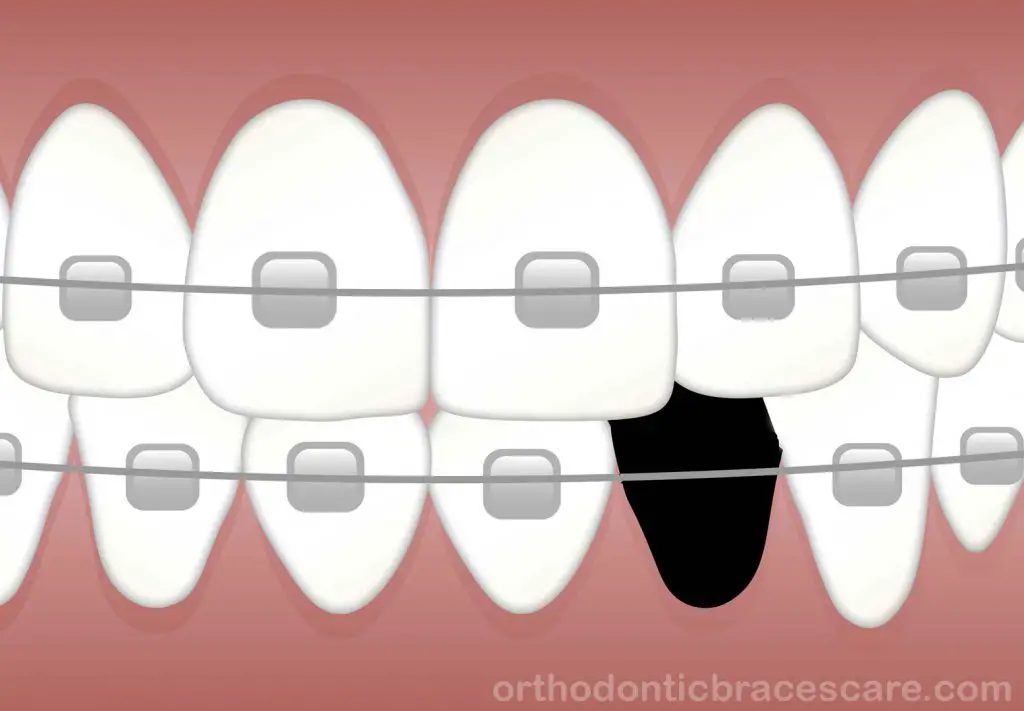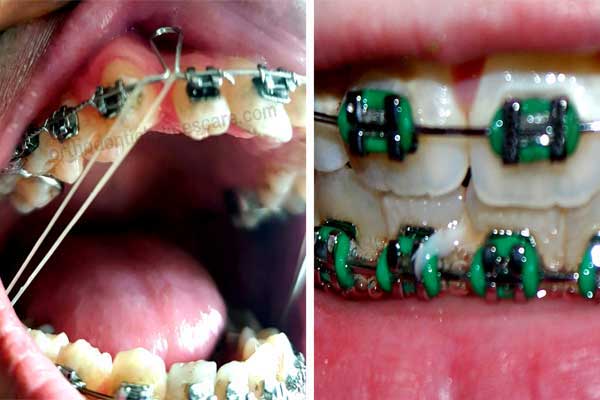Last updated on August 17th, 2022 at 02:35 pm
When you have a missing tooth or your dentist has extracted your teeth for alignment, you may get worried and want to know, “Can Braces Close Missing Teeth Gap?“
Braces can close gaps from missing teeth when the gap is small or the tooth is extracted to align the remaining teeth properly. However, if the cause of missing teeth is an injury or poor dental health, a dental prosthesis may be required to fix it.
Various components are attached to braces to close the gaps such as power chains or coil springs.
The duration required to fix the gaps with braces may vary depending on the treatment plan, type of case, and other factors.
Now, how’ll you know whether it’s going to work for you or whether you’ll still have gaps between teeth after braces? And, what to do if braces can’t close the gap?
In this article, you’ll know when Braces can fix gaps from missing teeth and how long it may take. Besides, you’ll get alternative ways to replace missing teeth.
Can you get braces with missing teeth?
With missing teeth, you can get braces to correct crowding or straighten your teeth. In fact, braces are one of the best ways to fix misaligned teeth, even if you are missing teeth. However, to fill in the gap left by your missing teeth, you could require additional treatment following the end of your orthodontic treatment, such as a dental veneer, bridge, or implant.

When can braces fix gaps from missing teeth?
Teeth gaps, including those between your front teeth or the top two incisors, can be readily closed with braces. But if you have missing teeth, it can be different.
Let’s look at those conditions.
Tooth removal for orthodontic treatment
When you have misaligned or crowded teeth, your orthodontist suggests teeth extraction for orthodontic treatment purposes.
A common example of that is when your orthodontist suggests you remove 1st premolar ( 4|4 ) teeth to correct your malocclusion. In this situation, closing extraction gaps with braces is indicated.
Usually, the removal of teeth is necessary here because the length of your arch which holds your teeth are short.
That means, to align teeth normally, your arch should hold a lesser number of teeth in this case.
So, if you are worried about “extraction gaps not closing,” you should know that this space will be closed after the completion of orthodontic treatment. So, keep your patience.
Extra or supernumerary tooth
Another circumstance is when you have an extra tooth. Usually, you may have an additional tooth between your upper incisor teeth. It’s called a supernumerary tooth.
It could have a poor aesthetic appearance, occasionally result in functional issues, or misalign your teeth.
So, you may need to get your supernumerary tooth removed. After that, you get braces to close the missing tooth gap.
This gap can be closed by braces easily just like closing normal spacing between the front teeth.
Now you may be curious and ask, “How do braces close extraction holes?” Let’s know it.
How can braces close the missing teeth gap?
Braces put pressure on your teeth and supporting bones. This causes teeth to move and close the gap. That’s why your orthodontist fixes brackets on your teeth and then attaches wires, springs, or elastics to them.
The attachments like power chains or coil springs provide force through the bracket to your teeth. This helps move teeth in the desired position.
- The power chain is an elastic band that is placed on the brackets where gaps are present. Because of the elastic property, it puts pressure on teeth which helps close the gaps.
- On the other hand, coil springs also help fix the gaps using their spring property. However, you should take care of the springs to prevent damage.
An orthodontist uses an optimal force to move a tooth, neither more nor less than that.
From a single visit, the dentist gives a little amount of force to your teeth.
Then, various types of reactions and changes occur to your tooth-supporting bone.
Alveolar bones support your teeth. So, these changes are necessary to move a tooth.
This creates favorable conditions to move the tooth along bones.
But, from one visit, you should expect a little movement of your tooth. After that, you won’t feel any extra pressure on your tooth.
On the next visit, which may be after 3 or 4 weeks, the orthodontist will apply force again.
That means every 3 to 4 weeks you have to visit the dentist for this to close the gap and complete orthodontic treatment.
After a few weeks to months, the tooth is moved to your desired position and the missing tooth gap is closed.
Check out my other article to know which types of gaps braces can close.
How long do braces take to close a missing tooth gap?
It might take six to eight months for traditional braces to fix the gaps from missing teeth. But not every case is the same. The duration depends on several factors such as the condition and position of your teeth, size of gaps, muscle function of your face, and tooth-supporting bones.
If the problem is not complicated such as small gaps, it may take less time. In more severe cases, the duration may be longer.
Suppose, you have only 2 mm gaps to close and another person has 4 mm gaps. Obviously, you will get faster results with braces than him.
However, it may take 1 or 2 years to complete the full treatment plan even after the closing of gaps.
The reason is the orthodontist also fixes your bite and corrects all related problems so that your teeth can function properly and you get a beautiful smile at the end of treatment.
Another factor that affects the duration is the treatment planning and the force that is applied to your teeth.
High force can result in significant damage, including the loss of teeth.
So, an orthodontist moves teeth using a gentle and optimal force. Following that, changes in the bone allow teeth to move more easily. Our body reacts to this procedure gradually. Therefore, it requires some time.
Can braces close gaps after extraction?
If you have had teeth extracted to make space for your braces, the gaps will close gradually as your other teeth move into place. The amount of time it takes for the gaps to close will depend on how much space was created by the extractions and the severity of your crowding.
However, if your tooth is removed for other causes such as an injury, infection, or decay, you may require a dental prosthesis to replace the tooth.
How long do braces take to close extraction gaps?
In general, it can take braces 6 to 8 months to fix a gap left by orthodontic tooth extraction. However, it will take you roughly 12 to 18 months to correct all orthodontic malocclusions and properly align your bite.
But, you need to know that braces may not be useful for any type of gaps from a tooth extraction.
When can’t braces help in closing the gaps from missing teeth?
In order to close a gap, braces can move nearby teeth toward your missing tooth.
However, it could not be useful if your dentition is in good alignment with no extra tooth, and you are missing a tooth.
This is because if you move a tooth in that gap, another gap will appear behind it. So, someone has to be clear about the purpose of moving a tooth.
Another important problem is missing a permanent tooth in the mouth. Sometimes, one or more permanent teeth may not erupt due to many reasons.
In these cases, your dentist will find out the cause and design a treatment plan. Braces can’t be helpful in these situations.
Even if your dentist moves your teeth, your occlusion or bite between your upper and lower teeth will not be normal.
This may lead to other problems, such as chewing or mastication problems, jaw pain, and recurrence of the previous problems.
So, the tooth to be moved should be placed in a favorable position. Moreover, if the gap is so small, braces can be useful.
This may be beneficial when you have crowded teeth. By moving your teeth, the gaps between them can be closed.
But in cases where the gaps are so big that it’s due to the missing of a tooth, it could be difficult to fix them with braces.
Can you have braces with missing front teeth?
You can still get braces to correct your crooked teeth if you have a missing front tooth. The only difference is that you may need to close the gap by some other means such as a dental implant, or, a dental bridge.
Moreover, even if you use braces with missing front teeth, your crowded or misaligned teeth can be corrected properly.
Can you get braces with missing back teeth?
You can still have braces to correct your occlusion and straightened your teeth, even if you have missing back teeth. However, braces might not close the molar teeth gap completely. So, you might need a dental implant, a dental bridge, or other dental prostheses to close the gaps after braces come off.
Can braces fix a gap from a missing front tooth?
Braces are a great choice to close a gap left by a supernumerary or an extra tooth between upper front teeth after its removal. But, when you have a gap from a missing permanent incisor due to an accident or injury, braces may not be helpful to close that space.
You may wonder why it is. But, the answer is simple. You are missing an incisor tooth and the canine should be moved to that place, how would you look like?
Of course, aesthetically it isn’t good. Also, you will bite or mastication problems.
In these circumstances, a dental implant, denture, or bridge may be the treatment choice.
However, if you have midline spacing, braces treatment is a great choice.
The alternatives to braces to close the missing tooth gap
Some people don’t like braces because of the roughness and esthetic problem. So, question is, can a dentist close a gap without braces? Here are the alternatives to braces.
Invisalign or clear aligners
As Invisalign looks good esthetically and it’s comfortable and easy to use, you can get it for missing tooth gaps. It can be helpful in mild to moderate cases.
But, unfortunately, an Invisalign can’t help in all cases of orthodontic tooth extraction. In some cases, it works well and in other cases, traditional braces are better than Invisalign to close an extraction tooth gap.
Invisalign can close the gap between your teeth, called diastema. Again there are limitations. It can close small gaps up to 5-6 mm.
But, in case of large gaps, it’s not possible to fix the gap. Also, Invisalign can’t be helpful if you have a missing tooth.
Know when you can get Invisalign to fix gaps.
Retainers
An active retainer can also close minor gaps between teeth. This is a removable appliance with a labial is just like a retainer that you get after braces treatment. The only difference is it can apply pressure on teeth to close the gaps.
It’s only helpful for growing children if the gap is small. But, it’s not good as braces or Invisalign.
Find out all the alternatives to braces to fix gaps between teeth.
Dental prostheses required to close missing teeth gap
Let’s a look at the prostheses that help you when braces can’t fix the gap:
Dental Implant
It’s the best choice when you are missing a tooth due to a condition such as caries, trauma, periodontitis, etc.
The reason for that a dental implant resembles a natural tooth elastically as well as functionally.
Other prostheses may only have an artificial crown portion, but the implant has an artificial root which gives more stability.
It doesn’t strain or get damaged easily and lasts long. But, it’s costly and requires a surgical procedure. So, all may not be able to get this.
Dental Bridge
If you can’t afford to have an implant, a bridge is the second choice for you. It can be helpful when you are missing 1-2 teeth in a row. The bridge is made up of two or more artificial teeth, called pontics, and they are anchored by an abutment on either side.
But, as it doesn’t have an artificial root, it isn’t as stable as the dental implant. So, you may feel some discomfort and have trouble speaking or eating.
Besides, you may not get proper function or it may not last more than 6 to 7 years like a dental implant. Though it’s not the best option, you may also have it.
Dental veneer or composite build-up
If you have a pre-existing missing tooth gap due to a cause other than orthodontic treatment, after the end of the treatment, you may need to close it with a dental veneer or by composite build-up. It may be required when you have small gaps.
Dental veneers are thin porcelain shells that are placed on the front of your teeth. It looks like natural teeth and can be helpful to improve the appearance of your smile.
But, it’s not possible to use dental veneers or composite build-up to close the gaps between teeth. So, if you want to use veneers for cosmetic purposes, it may be helpful.
But, in terms of functionality and to improve your oral health, it would be better to choose braces.
Denture
You can also use a prosthesis that can be removable or fixed. A removable denture is very helpful if you want a temporary solution for your missing tooth.
Here, an artificial tooth takes support from a plate and other teeth. But, these dentures may cause many problems.
It strains or breaks easily. Moreover, carrying this prosthesis may not be comfortable for you and functional support is very poor.
Check out 15 Essential Braces Survival Kits
What to do about deciduous teeth missing gaps?
If your baby loses a deciduous or milk tooth, he won’t need braces to close the gaps. Instead, an orthodontist will use a space maintainer to maintain the space for the permanent tooth that’s going to erupt in that space.
It means that when the permanent tooth will erupt, it will take the place left by the deciduous tooth. So, there is nothing to worry about.
However, when a permanent tooth doesn’t erupt in that place, we may consider other treatment procedures. So, keep in touch with your orthodontist.
Braces or implants: which one is needed for missing teeth?
Now you understand when braces can fix gaps from missing teeth and in which condition they can’t be useful.
But, you may need a dental prosthesis such as dental implants, dentures, or bridges when the gap between teeth is due to a reason other than orthodontic conditions.
Usually, these prostheses are recommended for a missing tooth due to a condition like tooth decay, periodontal disease, or trauma, you need a prosthesis.
What should be used for your missing tooth depends on several conditions such as the amount of space, tooth position, occlusion, and esthetic and functional criteria.
So, can braces close big gaps?
Braces can fix the big gaps between teeth if the condition is due to an orthodontic purpose or condition. Various prostheses might be required in other circumstances.
How long to close gaps when 4 teeth are extracted for braces?
The time required to fix the gaps after 4 teeth are extracted for braces usually takes 12 to 18 months. During this time, not only gaps are closed but, the teeth are aligned properly. However, it may vary depending on your individual condition.
Takeaways
When a tooth is extracted for perfect tooth alignment, braces can fix any gaps left by missing teeth, extra or supernumerary teeth, and extracted premolars or other teeth. Invisalign can be a fantastic solution if you need to close the gaps without using braces.
The necessity for a dental implant, bridge, or dentures may arise if the space left by the missing tooth is substantial due to caries, trauma, periodontal disease, or other diseases.
If you need braces to fix gaps from missing teeth, consult with a good orthodontist and he or she will recommend the correct course of treatment for you.
Always seek advice from your dentist or orthodontist and follow it.

Dr. Pallab Kishore, MS in Orthodontics and owner of Orthodontic Braces Care, shares expert tips on braces, aligners, and oral health from 10+ years of experience.


